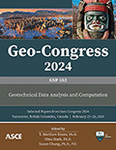Considerations for Augmented Flood Control Infrastructure Inspection Using Convolutional Neural Networks
Publication: Geo-Congress 2024
ABSTRACT
Earthen flood control structures such as dams and levees are vital for managing flood risk. In the United States alone, the United States Army Corps of Engineers manages approximately 14,000 mi of levees, with an average age of 59 years. Current inspection standards consist of walking or driving along the levee looking for important performance indicator signs. Manually inspecting levees for such conditions is time consuming, in certain instances possibly dangerous to inspectors, and is susceptible to human subjectivity in some instances with the sheer quantity of levees to inspect. In recent years across the broader civil infrastructure industry, remote inspection technologies, such as unmanned aerial vehicles, have begun seeing use and allowing for systems to be inspected faster and safer than traditional methods. The data obtained from these remote inspection tools can then be utilized with machine learning algorithms to classify and identify both failures, and potential future failure locations. This combination of rapid remote inspection for data collection, and machine learning for data processing, provides a powerful tool to enhance the condition monitoring of levees rapidly, efficiently, and remotely. This paper outlines some current technologies and use cases of these tools for levee inspections and discusses ongoing work related to machine vision and machine learning automation of visual imagery applied to crack detection using convolutional neural networks, where an accuracy of up to 99.76% is achieved for crack detection using a database of 20,800 images of concrete.
Get full access to this article
View all available purchase options and get full access to this chapter.
REFERENCES
Aanstoos, J. V., Hasan, K., O’Hara, C. G., Prasad, S., Dabbiru, L., Mahrooghy, M., Nobrega, R., Lee, M., and Shrestha, B. (2010). Use of remote sensing to screen earthen levees. 2010 IEEE 39th Applied Imagery Pattern Recognition Workshop (AIPR), Washington, DC, 1–6. IEEE. doi: https://doi.org/10.1109/AIPR.2010.5759704.
Burkov, A. (2019). The hundred-page machine learning book (Vol. 1, p. 32). Quebec City, QC, Canada: Andriy Burkov.
Congress, S. S. C., Puppala, A. J., Kumar, P., and Verreault, L. (2023). Application of Unmanned Aerial Vehicle (UAV) for Reservoir Embankment Inspections. In Geo-Congress 2023 (pp. 516–525).
Dabbiru, L., Aanstoos, J. V., and Younan, N. H. (2016). Earthen levee slide detection via automated analysis of synthetic aperture radar imagery. Landslides, 13, 643–652.
de Jeu, R., Parinussa, R., Biemond, L., Haarbrink, R., Shutko, A., Demontoux, F., and Provoost, Y. (2010). Safety inspection of levees with L-band radiometry. 2010 11th Specialist Meeting on Microwave Radiometry and Remote Sensing of the Environment, Washington, DC, 96–98. IEEE. doi: https://doi.org/10.1109/MICRORAD.2010.5559583.
Dunbar, J. B., Galan-Comas, G., Walshire, L. A., Wahl, R. E., Yule, D. E., Corcoran, M. K., Bufkin, A. L., and Llopis, J. L. (2017). Remote sensing and monitoring of earthen flood-control structures. Engineer Research and Development Center,. Vicksburg, MS.
Fernandes, O., Murphy, R., Adams, J., and Merrick, D. (2018). Quantitative data analysis: CRASAR small unmanned aerial systems at hurricane Harvey. 2018 IEEE International Symposium on Safety, Security, and Rescue Robotics (SSRR), Philadelphia, PA, 1–6. IEEE. doi: https://doi.org/10.1109/SSRR.2018.8468647.
Hossain, A. A., Easson, G., and Hasan, K. (2006). Detection of levee slides using commercially available remotely sensed data. Environmental & Engineering Geoscience, 12(3), 235–246.
Iqbal, U., Barthelemy, J., Perez, P., and Li, W. (2021). Blockage of Cross Drainage Hydraulic Structures: Emerging Role of Artificial Intelligence and Machine Learning. Academia Letters, 2.
Iqbal, U., Barthelemy, J., Li, W., and Perez, P. (2021). Automating visual blockage classification of culverts with deep learning. Applied Sciences, 11(16), 7561.
Iqbal, U., Barthelemy, J., and Perez, P. (2022). Prediction of hydraulic blockage at culverts from a single image using deep learning. Neural Computing and Applications, 34(23), 21101–21117.
Kuchi, A., Hoque, M. T., Abdelguerfi, M., and Flanagin, M. C. (2019). Machine learning applications in detecting sand boils from images. Array, 3, 100012.
Kuchi, A., Hoque, M. T., Abdelguerfi, M., and Flanagin, M. C. (2020). Levee-crack detection from satellite or drone imagery using machine learning approaches. IGARSS 2020-2020 IEEE International Geoscience and Remote Sensing Symposium, Waikoloa, HI, 976–979. IEEE. doi: https://doi.org/10.1109/IGARSS39084.2020.9323936.
Macaulay, M. O., and Shafiee, M. (2022). Machine learning techniques for robotic and autonomous inspection of mechanical systems and civil infrastructure. Autonomous Intelligent Systems, 2(1), 8.
Ozgenel, C. F. (2019). “Concrete Crack Images for Classification”, doi: https://doi.org/10.17632/5y9wdsg2zt.2.
Sarker, I. H. (2021). Machine learning: Algorithms, real-world applications and research directions. SN computer science, 2(3), 160.
USACE. (2018)., March 2018. U.S. Army Corps of Engineers.
USACE. (2023). Evaluation, Design, and Construction of Levees. U.S. Army Corps of Engineers.
Information & Authors
Information
Published In
History
Published online: Feb 22, 2024
ASCE Technical Topics:
- Analysis (by type)
- Artificial intelligence and machine learning
- Computer programming
- Computing in civil engineering
- Construction engineering
- Construction management
- Data collection
- Engineering fundamentals
- Failure analysis
- Floods
- Hydraulic engineering
- Hydraulic structures
- Inspection
- Levees and dikes
- Methodology (by type)
- Neural networks
- Research methods (by type)
- Structural control
- Structural engineering
- Structural health monitoring
- Water and water resources
Authors
Metrics & Citations
Metrics
Citations
Download citation
If you have the appropriate software installed, you can download article citation data to the citation manager of your choice. Simply select your manager software from the list below and click Download.
